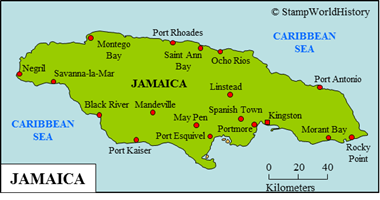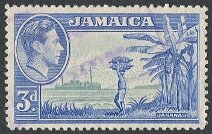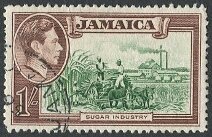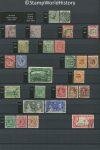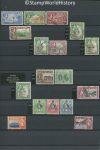
Jamaica
British colony

Jamaica
Independent
Quick reference
General issues: British colony 1860-1944, British colony/Self government 1944-1958, British colony/West Indies Federation 1958-1962, Independent within the British Commonwealth 1962-Present
Country name on general issues: Jamaica
Currency: 1 Pound = 20 Shilling, 1 Shilling = 12 Pence 1860-1969, 1 Dollar = 100 Cents 1969-Present
Population: 720 000 in 1900, 2 950 000 in 2015
Political history Jamaica
Spanish and British rule
Jamaica is located in the Caribbean as one of the Greater Antilles. Prior to colonization, Jamaica was inhabited by the Taino, an Amerindian people found on many of the Caribbean islands. The first European to explore Jamaica was Christopher Columbus in 1494. Jamaica was claimed for Spain and first settled by the Spanish in 1509. The Spanish named the colony Santiago. In 1655, the British first settled on the island. Since the British settlements were being attacked by the Spanish, the British allowed privateers to settle in Jamaica as a means of defense against Spanish attacks. In 1670, Spain ceded Jamaica to Great Britain. The privateers were evicted and the colony of Jamaica was established. From Jamaica, several other British possessions were administered: British Honduras – the current Belize – until 1884, and the Cayman and Turks & Caicos Islands until 1959.
Independent Jamaica
The first step towards independence was taken in 1944, when Jamaica gained limited self government. In subsequent years, further steps were taken and Jamaica gradually became more self governing. In 1958, Jamaica joined the West Indies Federation – a short lived federation of British possessions in the Caribbean that existed between 1958 and 1962. In 1962, Jamaica became an independent state within the British Commonwealth, which it is until today. Since the 1940’s, Jamaican politics have been dominated by two parties: the conservative – center right Jamaica Labour Party and the social-democratic – center left People’s National Party. Since independence these parties have alternated in governing Jamaica.
Economy
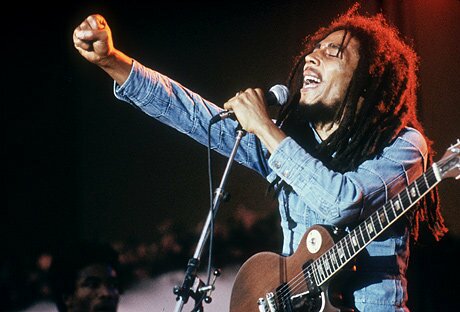
The first association many people will have with Jamaica could well be reggae music – with Bob Marley as probably its most well known exponent.
The Spanish, to whom Jamaica was of less importance, developed the colony as a plantations economy, on a limited scale. To the contrary, the British, in the 18th century, developed Jamaica into a large scale plantations colony – the cash crop being sugar cane. The abolition of slavery in 1834, increased competition from other countries, and declining sugar cane prices caused a transition from large scale plantations to small scale holdings, owned by former slaves. In the late 19th century bananas were introduced that, in the early 20th century, surpassed sugar cane as the most important crop. Thus, agriculture was long the mainstay of the Jamaican economy. In the second half of the 20th century the balance shifted to first manufacturing and bauxite mining, and later services – most notably tourism. On the United Nations Human Development Index, Jamaica qualifies as a High Development Country.
Demographics
The indigenous Taino became all but extinct in the 17th century, and to man the plantations the Spanish brought the first black slaves to Jamaica. As the British established large plantations in the 18th century, ever larger numbers of slaves were brought to Jamaica. By the end of the 18th century the slaves outnumbered the planters of European descent by twenty to one. Currently, the vast majority of the population is black – 92%. A small minority of 5% is of mixed origin. First in the late 19th and early 20th centuries, and again since the 1960’s, large numbers of Jamaicans have emigrated. Currently, an estimated 2.5 million Jamaicans, or people of Jamaican descent, live abroad. As a consequence, remittances account for 30% of the Jamaican GDP.
Postal history Jamaica
In 1671, Jamaica was the first British colony to open a post office, and by 1859 the number of post offices had grown to 54. These used the general British issues from 1858. The first stamps were issued for Jamaica in 1860. This first issue shows the portrait of Queen Victoria in a number of different frames. Of interest is that the watermark is a pineapple. Subsequent issues in the classical period are a blend of designs specific for Jamaica and designs common to the British colonies in general. Jamaica has participated in several of the omnibus issues for the British colonies. A 1951 issue in commemoration of the opening of the university for the British West indies on Jamaica, constitutes an omnibus issue for the British West Indies as most British possessions in the West Indies took part in the issue. In the modern era Jamaica has mainly issued stamps with themes of national interest.
The stamps of Jamaica were used in the Turks & Caicos Islands until 1867 and in the Cayman Islands until 1901.
Album pages
← Previous page: IniniNext page: Leeward Islands →

